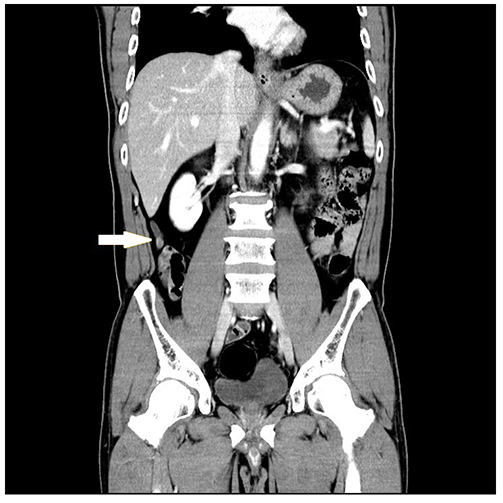Korean J Gastroenterol.
2019 Jan;73(1):45-49. 10.4166/kjg.2019.73.1.45.
Acute Suppurative Appendicitis Diagnosed by Acute Lower Gastrointestinal Hemorrhage
- Affiliations
-
- 1Division of Gastroenterology, Department of Internal Medicine, Korea University Ansan Hospital, Ansan, Korea. jskoo@korea.ac.kr
- 2Department of Pathology, Korea University Ansan Hospital, Ansan, Korea.
- KMID: 2432436
- DOI: http://doi.org/10.4166/kjg.2019.73.1.45
Abstract
- A 49-year-old man visited the emergency room of Korea University Ansan Hospital with hematochezia starting the day before the visit. Recently, he was on anti-platelet medication due to hypertension. The patient had no definite symptoms other than hematochezia. Digital rectal exam was positive and laboratory tests showed severe anemia. Sigmoidoscopy was initiated and almost no fecal material was observed in the intestinal tract, allowing insertion into the cecum. Active bleeding from the appendiceal opening was noted. On abdominal CT, contrast enhancement was observed at the tip of the appendix. Under suspicion of acute appendicitis, we consulted with a surgeon. The patient underwent appendectomy with partial cecal resection. Pathologic examination revealed a diagnosis of appendix bleeding due to acute suppurative appendicitis. The patient had no further bleeding after surgery and was discharged in a stable state. Careful observation by the endoscopist is necessary for accurate diagnosis of lower gastrointestinal hemorrhage. Appendiceal hemorrhage is very rarely reported, but it has various pathophysiologies. CT scan is useful when appendiceal hemorrhage is confirmed by endoscopic findings. Surgical treatment was needed in almost all cases reported worldwide. If bleeding from the appendix is confirmed, surgical treatment should be considered for both therapeutic and diagnostic purposes.
MeSH Terms
Figure
Cited by 1 articles
-
하부위장관 출혈로 나타난 급성 호산구성 충수염
So Ra Ahn, Joo Hyun Lee
Korean J Gastroenterol. 2021;78(2):134-137. doi: 10.4166/kjg.2021.063.
Reference
-
1. Lee SL, Walsh AJ, Ho HS. Computed tomography and ultrasonography do not improve and may delay the diagnosis and treatment of acute appendicitis. Arch Surg. 2001; 136:556–562.
Article2. Rao PM, Rhea JT, Novelline RA, et al. Helical CT technique for the diagnosis of appendicitis: prospective evaluation of a focused appendix CT examination. Radiology. 1997; 202:139–144.
Article3. Milewski PJ. Appendix abscess with intestinal haemorrhage. Br Med J. 1977; 1:147.
Article4. Monaghan K, Cogbill TH. Primary aortoappendiceal fistula: case report and review of the literature. J Vasc Surg. 2002; 35:1284–1286.
Article5. Arnbjörnsson E, Bengmark S. Role of obstruction in the pathogenesis of acute appendicitis. Am J Surg. 1984; 147:390–392.
Article6. Strate LL, Gralnek IM. ACG clinical guideline: management of patients with acute lower gastrointestinal bleeding. Am J Gastroenterol. 2016; 111:459–474.
Article7. Chung IH, Kim KH. A case of successful colonoscopic treatment of acute appendiceal bleeding by endoclips. J Korean Soc Coloproctol. 2011; 27:329–332.
Article8. Kyokane T, Akita Y, Katayama M, et al. Angiodysplasia of the appendix. Am J Gastroenterol. 2001; 96:242–244.
Article9. Konno Y, Fujiya M, Tanaka K, et al. A therapeutic barium enema is a practical option to control bleeding from the appendix. BMC Gastroenterol. 2013; 13:152.
Article10. Bjarnason I, Hayllar J, MacPherson AJ, Russell AS. Side effects of nonsteroidal anti-inflammatory drugs on the small and large intestine in humans. Gastroenterology. 1993; 104:1832–1847.
Article11. Davies NM. Toxicity of nonsteroidal anti-inflammatory drugs in the large intestine. Dis Colon Rectum. 1995; 38:1311–1321.
Article12. Fortun PJ, Hawkey CJ. Nonsteroidal antiinflammatory drugs and the small intestine. Curr Opin Gastroenterol. 2007; 23:134–141.
Article
- Full Text Links
- Actions
-
Cited
- CITED
-
- Close
- Share
- Similar articles
-
- Acute Eosinophilic Appendicitis: A Rare Cause of Lower Gastrointestinal Hemorrhage
- Acute Appendicitis Diagnosed by Colonoscopy
- Tuberculosis of the Appendix Associated with as Acute Suppurative Inflammatory Reaction: A case report
- A Case of Acute Appendicitis Diagnosed during Colonoscopy
- A Case of Acute Appendicitis Diagnosed by Colonoscopy





